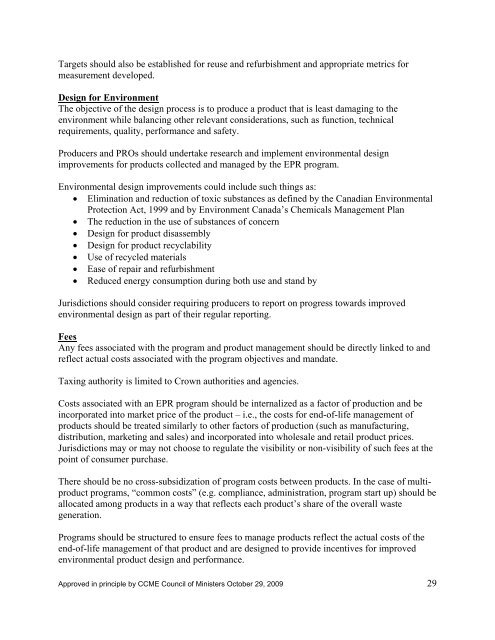Canada-Wide Action Plan for Extended Producer ... - CCME
Canada-Wide Action Plan for Extended Producer ... - CCME
Canada-Wide Action Plan for Extended Producer ... - CCME
You also want an ePaper? Increase the reach of your titles
YUMPU automatically turns print PDFs into web optimized ePapers that Google loves.
Targets should also be established <strong>for</strong> reuse and refurbishment and appropriate metrics <strong>for</strong><br />
measurement developed.<br />
Design <strong>for</strong> Environment<br />
The objective of the design process is to produce a product that is least damaging to the<br />
environment while balancing other relevant considerations, such as function, technical<br />
requirements, quality, per<strong>for</strong>mance and safety.<br />
<strong>Producer</strong>s and PROs should undertake research and implement environmental design<br />
improvements <strong>for</strong> products collected and managed by the EPR program.<br />
Environmental design improvements could include such things as:<br />
• Elimination and reduction of toxic substances as defined by the Canadian Environmental<br />
Protection Act, 1999 and by Environment <strong>Canada</strong>’s Chemicals Management <strong>Plan</strong><br />
• The reduction in the use of substances of concern<br />
• Design <strong>for</strong> product disassembly<br />
• Design <strong>for</strong> product recyclability<br />
• Use of recycled materials<br />
• Ease of repair and refurbishment<br />
• Reduced energy consumption during both use and stand by<br />
Jurisdictions should consider requiring producers to report on progress towards improved<br />
environmental design as part of their regular reporting.<br />
Fees<br />
Any fees associated with the program and product management should be directly linked to and<br />
reflect actual costs associated with the program objectives and mandate.<br />
Taxing authority is limited to Crown authorities and agencies.<br />
Costs associated with an EPR program should be internalized as a factor of production and be<br />
incorporated into market price of the product – i.e., the costs <strong>for</strong> end-of-life management of<br />
products should be treated similarly to other factors of production (such as manufacturing,<br />
distribution, marketing and sales) and incorporated into wholesale and retail product prices.<br />
Jurisdictions may or may not choose to regulate the visibility or non-visibility of such fees at the<br />
point of consumer purchase.<br />
There should be no cross-subsidization of program costs between products. In the case of multiproduct<br />
programs, “common costs” (e.g. compliance, administration, program start up) should be<br />
allocated among products in a way that reflects each product’s share of the overall waste<br />
generation.<br />
Programs should be structured to ensure fees to manage products reflect the actual costs of the<br />
end-of-life management of that product and are designed to provide incentives <strong>for</strong> improved<br />
environmental product design and per<strong>for</strong>mance.<br />
Approved in principle by <strong>CCME</strong> Council of Ministers October 29, 2009 29
















